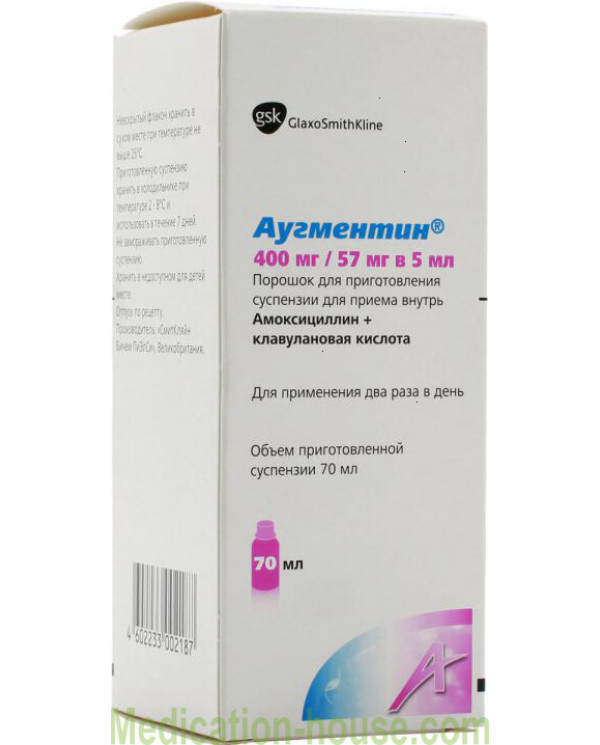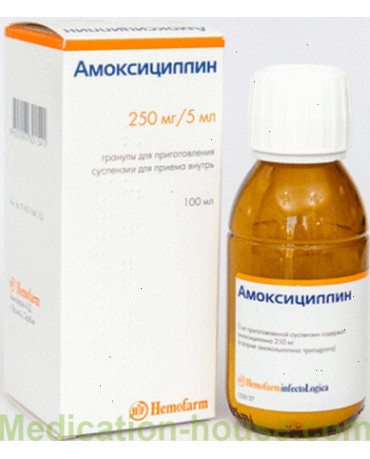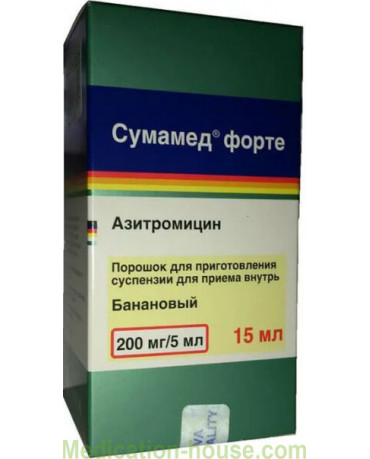Instruction for Augmentin suspension
You can buy Augmentin suspension here
Augmentin suspension is a combined drug of the penicillin group of synthetic broad-spectrum antibiotics.
Designed to treat adults and children. As part of augmentina - active substances amoxicillin trihydrate and potassium clavulanate (clavulanic acid).
Form of augmentin - tablets, syrup, powder for injection, dry matter for the preparation of suspensions. Syrup and suspension are intended for the treatment of children under 12 years old. This form of the drug is quite easily tolerated even by the smallest patients. However, when taking it is necessary to be careful, as there is a risk of allergic reactions.
Release form and composition
The medication consists of:
Amoxicillin (it is represented by trihydrate);
Clavulanic acid (it is presented in the form of potassium salt).
Powder. It is intended for the manufacture of oral suspension. The following excipients are used: dry flavors (orange, “Bright molasses”, raspberry), succinic acid, colloidal silicon dioxide, xanthan gum, hydroxypropylmethylcellulose, aspartame. Contained powder inside the vials. The bottle is placed in a packaging made of cardboard.
The powder intended for the manufacture of a suspension, is produced in the UK ("SmithKline Beecham Pharmaceuticals").
Pharmacological effect
Marked bacteriolytic effect. The drug is active for aerobic / anaerobic gram-positive, aerobic gram-negative microorganisms. It is very effective against strains that are capable of producing beta-lactamase. Under the influence of clavulanic acid, amoxicillin is more resistant to the effects of a substance such as beta-lactamase. At the same time there is an expansion of the effects of this substance.
The drug is active against:
Legionella;
Yersinia enterocolitica;
Streptococcus pneumoniae;
Fusobacterium;
Bordetella pertussis;
Peptococcus spp .;
Bacillus anthracis;
Peptostreptococcus spp .;
Enterococcus faecium;
Streptococcus agalactiae;
Vibrio cholerae;
Listeria monocytogenes;
Borrelia burgdorferi;
Moraxella catarrhalis;
Streptococcus;
Proteus mirabilis;
Peptococcus spp .;
Leptospira icterohaemorrhagiae;
Streptococcus pyogenes;
Neisseria meningitidis;
Treponema pallidum;
Helicobacter pylori;
Brucella spp .;
Streptococcus viridans;
Gardnerella vaginalis;
Haemophilus influenza.
When prescribing a medicine to a child, the doctor must calculate for him the necessary amount of suspension.
Indications for use
Augmentin suspension is prescribed for infections of a bacterial nature caused by microorganisms that are sensitive to the antibiotic:
infections of bones and joints: osteomyelitis;
odontogenic infections: periodontitis, odontogenic maxillary sinusitis, severe dental abscesses;
infections of the skin, soft tissue;
respiratory tract infections: bronchitis, lobar bronchopneumonia, empyema, lung abscess;
infections of the urogenital system: cystitis, urethritis, pyelonephritis, abortion sepsis, syphilis, gonorrhea, infections of organs in the pelvic region;
infections arising as a complication after surgery: peritonitis.
The same drug is used in therapy, prevention of infectious complications that may occur during operations on the gastrointestinal tract, neck, head, pelvis, kidneys, joints, heart, bile ducts.
Contraindications
All Augmentin suspension dosage forms are contraindicated for use if a person has the following conditions or diseases:
Allergic reaction or hypersensitivity to amoxicillin, clavulanic acid or antibiotics from the penicillin group or cephalosporins;
The development of jaundice and liver dysfunction in the past on the background of the use of drugs containing amoxicillin and clavulanic acid.
Some Augmentin suspension dosage forms in addition to the above have the following additional contraindications:
1. Suspension 125 / 31,25:
Phenylketonuria.
2. Suspensions 200 / 28.5 and 400/57:
Phenylketonuria;
Creatinine clearance less than 30 ml / min;
Age less than 3 months.
3. Tablets of all dosages (250/125, 500/125 and 875/125):
Age under 12 years or body weight less than 40 kg;
Creatinine clearance less than 30 ml / min (for tablets 875/125 only).
Instructions for use
Children under the age of 12 or having a body weight less than 40 kg should take Augmentin only in the form of a suspension. In this case, infants younger than 3 months can only be given a suspension with a dosage of 125 / 31.25 mg. In children older than 3 months of age, it is allowed to use suspensions with any dosages of the active ingredients. It is precisely because Augmentin suspension is intended for children, it is often called simply “baby Augmentin, without indicating the dosage form (suspension). Dosage suspensions are calculated individually based on the age and body weight of the child.
The instructions for use indicate that the desired amount of the finished suspension (solution) is measured using a measuring cup or syringe. To take the medicine for children, you can mix the suspension with water, in a one-to-one ratio, but only after the required dosage has been determined.
In order to reduce discomfort and side effects from the gastrointestinal tract, it is recommended to take tablets and suspension at the beginning of a meal. However, if this is not possible for any reason, then pills can be taken at any time regarding food, since the food does not have a significant effect on the effects of the drug.
Taking tablets and suspensions, as well as intravenous administration of Augmentin solution should be made at regular intervals. For example, if you need to take the drug twice a day, you should maintain the same 12-hour interval between doses. If it is necessary to take Augmentin 3 times a day, then it should be done every 8 hours, trying to strictly observe this interval, etc.
To calculate the amount of the drug, you must use the following rules:
Suspension 200 mg.
Up to one year, weight from 2 to 5 kg. - 1.5 - 2.5 ml 2 times a day;
From 1 to 5 years, weight from 6 to 9 kg - 5 ml 2 times a day.
Suspension 400 mg.
Children from a year to 5 years old, weight from 10 to 18 kg - 5 ml 2 times a day;
From 6 to 9 years old, weighing from 19 to 28 kg -7.5 ml 2 times a day;
Children From 10 to 12 years old, weight from 29 to 39 kg - 10 ml twice a day.
Suspension 125 mg.
Up to one year, weight from 2 to 5 kg - 1.5 - 2.5 ml 3 times a day;
Children from one year to 5 years, weight from 6 to 9 kg - 5 ml 3 times a day;
From one year to 5 years, weight from 10 to 18 kg - 10 ml 3 times a day;
From 6 to 9 years, weight from 19 to 28 kg - 15 ml 3 times a day;
From 10 to 12 years, weight from 29 to 39 kg - 20 ml 3 times a day.
Dosing of the drug is calculated depending on the type of infection, the stage of the course, the weight and age of the patient. It must be remembered that only the doctor can prescribe the desired dosage to the patient. When calculating the dosage is recommended to consider only the content of amoxicillin sodium.
Suspension preparation rules
Suspension must be prepared immediately before taking the drug. Cooking Rules:
You should add 60 ml of boiled water at room temperature to the powder container, close the lid and shake until the powder is completely dissolved. Next, you need to give capacity to stand for 5 minutes, this allows for the complete dissolution of the drug.
Add water to the mark on the container with the medicine and shake the bottle again.
For a dose of 125 mg / 31.25 mg, 92 ml of water will be required; for a dose of 200 mg / 28.5 mg and 400 mg / 57 mg, 64 ml of water will be required.
The container with the medicine must be thoroughly shaken before each use. In order to ensure accurate dosing of the medication, it is recommended to use the measuring cap, which is attached in the kit. The measuring cap must be thoroughly cleaned after each use.
The shelf life of the finished suspension is not more than 1 week in the refrigerator. Suspension can not be frozen.
For patients younger than 2 years of age, the finished single dose of the drug can be diluted with boiled water 1: 1.
Side effects
The antibiotic is considered safe for children. The drug has been tested for many years, due to which the mechanism of its action has been rather well studied. Naturally, side effects may occur, but the probability of their appearance is quite low.
On the part of the digestive system can manifest such negative reactions: vomiting, nausea, diarrhea. While taking the antibiotic, diarrhea is a frequent side symptom. When using the suspension can change the color of the enamel on the child's teeth, it does not represent a great danger.
In certain cases, various allergic reactions may occur. Among them: anaphylactic shock, dermatitis, vasculitis, Stevens-Johnson disease. In certain cases, an allergic rash, erythema, urticaria develops. The child may experience severe pain in the head, dizziness.
A complete list of suspension Augmentin's side effects for children can be found in the instructions for the drug. As well as instructions for use contains a complete list of recommendations and dosages, how to conduct a course of antibiotic treatment.
To protect the body of the child from these undesirable phenomena, it is necessary to strictly observe the dosage of the drug, appointed by a qualified specialist.
Overdose
Overdose is manifested by dehydration, disorders of the digestive tract, a violation of the concentration of electrolytes in the blood.
In this case, symptomatic therapy is shown that supports the state of the internal organs of the baby. To avoid it, you must follow the instructions strictly, do not exceed the dose of the drug.
Drug interactions
When prescribed with anticoagulants (indirect), the effectiveness of these drugs will increase.
Combined use with antacids, laxative drugs or glucosamine worsens the absorbability of amoxicillin.
Suspension can be used with nitrofurans, for example, the drug Enterofuril.
You should not give the child Augmentin suspension with allopurinol, as this combination can cause skin allergies.
The drug is not prescribed together with methotrexate, since penicillins increase its toxicity.
At simultaneous appointment with macrolides (for example, with suspension Sumamed or Azitrox) suspension Augmentin's action will be weaker. The same effect is observed when combined with tetracyclines, sulfonamides, lincosamides and chloramphenicol.
Reviews
Most of the feedback from parents about Augmentin suspension is positive. Moms say that such an antibiotic helps to cope with many infections and is well tolerated by most children. They confirm that the treatment starts to act quickly with high fever, cough and other symptoms of infection. Within a few days from the beginning of the reception, the child's condition improves.
In the negative reviews complain about the side effects of the drug, such as nausea or diarrhea. Pediatricians, among whom Komarovsky, speak mainly about this antibacterial agent well, but they emphasize that only a doctor should prescribe this suspension to the child.
Storage conditions
The package containing the medication is recommended to be stored in a corner where children will not get it. It is necessary to select a dry place, the temperature in it should not be above 250C. For 7–10 days, you can store the finished suspension at a temperature of 2–8 degrees. The solution intended for intravenous injection should be used immediately after preparation.
Terms of sell
You can buy Augmentin suspension without a prescription.





